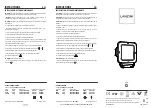
If the chassis of the vehicle is positive, the striped lead of the charger should connect to the
chassis and the unmarked lead should go to the output side of the fuse.
CHARGING AND USING THE LIGHT
The Survivor should be fully charged before use. Several charge and discharge cycles are
necessary to achieve full battery capacity. The Survivor is designed to be left on charge
continuously between uses. This insures that the light is always ready for use.
Fast Chargers
When the light is slipped into the charger, the red charge light will glow indicating that the
battery is being charged at the fast rate. When fully charged (an hour or less), the red light
will go out and the green light will come on. The battery will then be trickle charged as long
as power is applied to the charger. Both lights should go out when the flashlight is removed
from the charger. Reinsertion of the light starts a new charge cycle.
Best battery life will be achieved if the battery is fast charged in moderate temperatures. Fast
charging at low temperature may cause the battery to permanently lose some capacity. For
this reason, the DC FAST CHARGER is equipped with a temperature sensing system which
automatically adjusts the current for low temperature charging. This system works best when
the charger and the light are close to the same temperature. Avoid taking a Survivor from
a cold environment such as 40°F or lower and placing it into a warm charger. Allow the
Survivor to warm up for about a half hour before placing it in the charger. If the light and
charger are colder than 40°F, the charge indicators will not come on until the system warms.
Steady Charger
When the light is slipped into the charger, the red light will glow indicating that the battery
is being charged at a steady rate. Charging will continue as long as power is applied to
the charger. The light may be continuously charged in the steady charger at any temperature
above 0°F. The light should go out when the flashlight is removed from the charger.
PiggyBack Charger
When the battery is slipped into the charger, the red light will glow indicating that the
battery is being charged at a steady rate. Charging will continue as long as power is
applied to the charger. The battery may be continuously charged in the PiggyBack charger
at any temperature above 0ºF. The light should go out when the battery is removed from
the charger.
Operation
After the light has been charged, it may be used freely. If possible, avoid running the battery
down to the point where the lamp begins to significantly dim. There is no need to regularly
discharge or "condition" the battery to erase so called memory. This effect occurs rarely and
only under special conditions.The switch is located on the top of the light. Swing the switch
lever towards the front of the light for "on," towards the rear for "off."
To use the light in a hands-free mode, simply slide or clip onto a pocket, belt or strap or use
the built-in lanyard hole with a ring on the lanyard.
MAINTENANCE
Cleaning
Clean the light with mild soap and warm water. Avoid harsh detergents, abrasives and
solvents that could damage the plastic. For best performance, keep the lens clean. The
light, battery and charger can be stored long term in a cool, dry location for up to five (5)
years without harm.
Lamp Replacement
The lamp assembly may easily be replaced. Determine the correct replacement part for
your light as stated on the product label. Use only lamp module #90320 (Div. 1) or
90314 for Div. 2 product (see warning). Make sure that the switch is in the “off” position.
If the bulb is warm allow it to cool. Unscrew the facecap assembly from the light. Remove
the lamp assembly from the light. Insert the new lamp assembly straight into the housing,
being careful not to bend the contacts or the bulb pins. Be careful not to touch the bulb. It
is recommended to use finger cots or a clean tissue when installing the new lamp assem-
bly. Replace the facecap; focus is adjustable for optimum spot. Do not over-tighten. The
Survivor is again ready for use.
Battery Pack Replacement
The battery pack of the Survivor can be expected to give 500 to 1000 complete
charge/discharge cycles. When new, the battery should yield 90 to 100 minutes of
continuous run time, more with intermittent use. Should the performance decrease signifi-
cantly with age or use, you may want to replace the battery pack.
To replace the battery; release the latch or, for Div. 1 product, remove the two stainless
steel pins at the bottom of the light. The pins can be driven out from one side to the other
with an .090” punch. Hand pressure on the punch and base is generally sufficient to
remove the pins. Flip open or remove the base, note orientation with the battery. The
old battery will then slip out. The new pack can now be inserted. It is keyed; the base
will only close if the battery is inserted with the proper orientation. Do not force the
base closed. Hold the battery base firmly seated against the battery housing and at the
same time secure the latch or replace the pins fully in their holes. Remember to use only
Streamlight battery pack #90338 (Div. 2) or 90337 (Div. 1). See the product’s label
for the specific battery pack required for your particular light (see warning).
WARNING
:
Be sure to use only genuine Streamlight
®
replacement parts. The Survivor is
approved for use in hazardous locations only when Streamlight lamp assemblies and
battery packs are used. Important: To assure product safety and reliability, repairs other
than lamp or battery replacement should be performed at the Streamlight factory. Always
use Streamlight approved replacement parts, substitution may invalidate underwriter’s
approval.
NOTE
:
The rechargeable battery contained in this product is recyclable. At the end of its use-
ful life, under various country and state laws, it may be illegal to dispose of this battery in
the municipal solid waste stream. Check with your local solid waste officials for details in
your area for recycling options or proper disposal.























